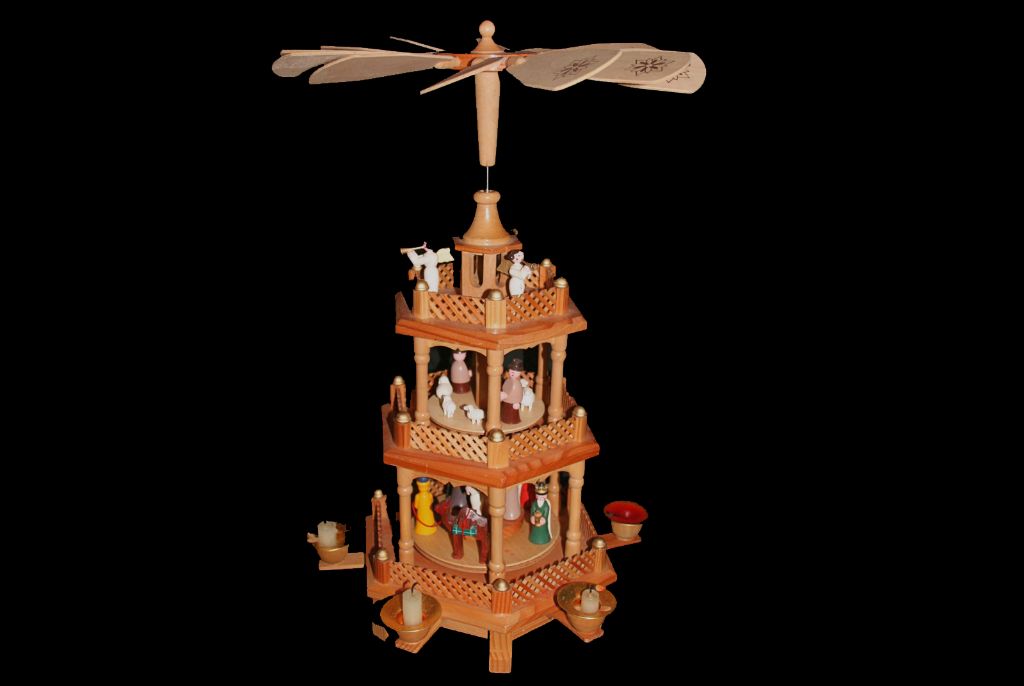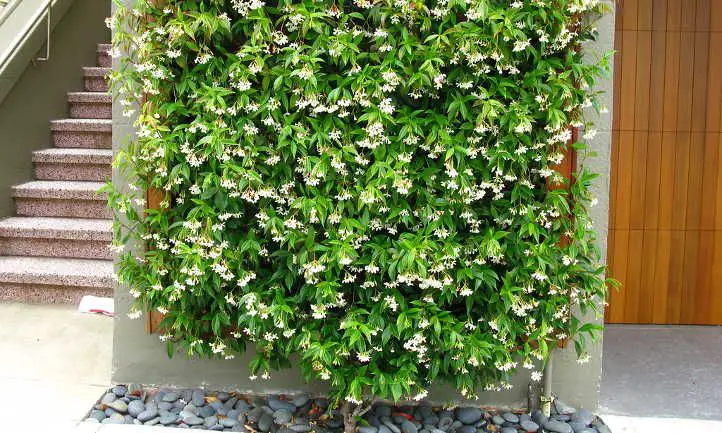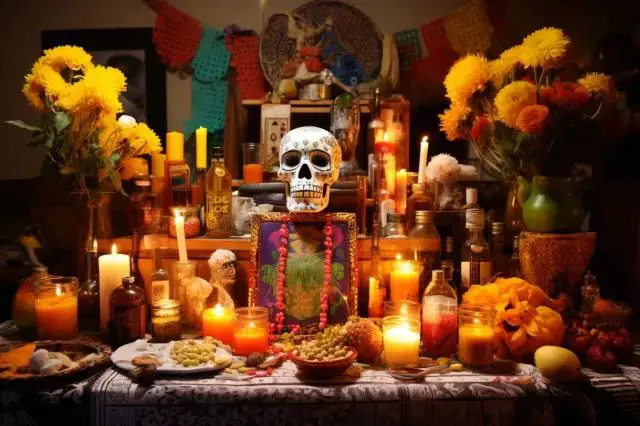How Does A German Christmas Pyramid Work?
A German Christmas pyramid (Weihnachtspyramide) is a traditional Christmas decoration that originated in the Ore Mountains of Germany in the 1800s. It consists of a carousel of figures that slowly rotates around a central rod when heated by candles. The pyramid gets its name from its distinctive pyramid shape.
Christmas pyramids have a long cultural history in Germany and are considered icons of German Christmas traditions. They were first created by candlemakers in the Ore Mountains as a clever way to advertise their candles. The pyramids’ mesmerizing motion quickly made them popular across Germany and they became established as a beloved Christmas decoration.
Today, Christmas pyramids are handcrafted collectibles that embody old-world German craftsmanship. Many families pass down their pyramids from generation to generation as treasured heirlooms. Their twinkling lights and charming motion continue to enchant both Germans and foreigners during the holiday season.
Materials
Christmas pyramids are traditionally handcrafted using materials like wood, paper, and metal. The base frame and axle mechanism are usually made of wood, while the ornamental components are constructed from paper, cardboard, or metal sheets.
Wood provides the structural support and is essential for the rotating mechanism. Hardwoods like birch, oak, and beech are common choices as they are dense and sturdy. The wood beams need to be precisely cut to size and joined together.
For the decorative elements, artisans use paper and cardboard which can be cut into intricate shapes and designs. Paper is lightweight, easy to cut and glue, and allows for adding color through painting or printing. Metallic foils and sheets are also used to create shiny gold and silver embellishments.
The choice of materials impacts the texture, color, and overall aesthetic. But the main consideration is durability, as the materials need to withstand heat from candles and the rotating motion.
Design
German Christmas pyramids typically have a distinctive four-sided design with multiple stacked levels that rotate around a central rod. Each of the four sides features elaborately carved wooden figurines and decorations. The levels or “tiers” that form the body of the pyramid are constructed out of wood, metal, or cardboard and fit onto the central metal rod. Each tier has four sloped sides and rotates independently around the rod thanks to fittings at the top of each level. This allows the tiers to catch the rising heat from the candles below, creating a convection effect that makes the ornamented levels slowly rotate as the candles burn. The four sides and stacked rotating tiers create the quintessential Christmas pyramid shape and motion.
The four sides usually depict different Christmas-themed scenes with carved wooden figurines, such as Mary, Joseph and the baby Jesus, the three wise men, Santa Claus, nutcrackers, and folk tale characters. The carved wooden decorations bring each scene to life and highlight the craftmanship involved. The slowly rotating tiers showcase the detailed figurines and ornamentation on all four sides of the pyramid. The tiered design provides a large surface area for elaborate Christmas decorations to be displayed and rotated for all to enjoy.
Mechanics
The ingenious mechanics of the Christmas pyramid are what allow it to rotate using only the heat and updraft from a candle. At the base of the pyramid is a rotor assembly consisting of horizontal metal arms radiating out from a central spindle. Small vanes are attached vertically on the ends of each arm. The candle is placed in the center, under the rotor.

As the flame heats the air, it creates an updraft which lifts through the pyramid. This updraft catches the vanes on the rotor arms, making them spin around the central spindle. The spindle is connected by a rod and gears to the levels above, causing them to rotate as well. The tiers are carefully balanced so they can turn freely.
The better the updraft, the faster the vanes and rotor spin, which in turn makes the pyramid rotate at a higher speed. More advanced models even have little propellers at the tips of the rotor arms to catch more draft. The simple yet ingenious candle-powered mechanics allow these Christmas pyramids to mesmerizingly turn all season long.
Candle
The candle plays a crucial role in allowing the Christmas pyramid to rotate. A candle is placed at the top of the pyramid, protected under a glass cover. When the candle is lit, it generates heat and warm air currents. As the hot air rises, it creates an updraft through the pyramid’s levels. This updraft enables the propellers and rotors to turn, setting the entire pyramid in motion.
The size and placement of the candle needs to be carefully engineered. The flame needs to be positioned right at the apex so the rising heat passes through the interior. The candle also needs to provide enough heat to generate a continuous updraft, but not so much that it poses a fire hazard. Many modern pyramids use electric candles for safety and convenience, but a real candle provides the authenticity of flame and convection that brings a pyramid to life.
Assembly
The assembly process for a traditional German Christmas pyramid is fairly straightforward, though it does require some specialized woodworking tools and skills. The main structural pieces like the central spire, crossbeams, and base are usually made from wood like pine or fir. The pieces are precisely cut and fitted together without nails or screws.
Holes are drilled in the central spire and crossbeams so they can slide onto the main shaft or rod that runs vertically through the pyramid. This allows the pieces to spin freely around the rod. The crossbeams are evenly spaced and attached perpendicular to the rod to provide stability and support.
Intricate decorations and figurines are added to the crossbeams once the main structure is assembled. These are also fitted onto the crossbeams or spire without glue or fasteners. The decorations are cut from wood, painted, and detailed. Assembly takes patience and care to ensure a balanced form and smooth spinning motion.
At the bottom, a heavy circular base provides weight and stability to the pyramid. The main rod is secured and stabilized here as well. Candles are fitted into holders on the base. Once completely assembled, the candle heat makes the pyramid spin as the warm air rises through the interior.
Figurines
The figurines found on traditional German Christmas pyramids are significant decorative elements that often represent traditional Christmas motifs. These miniature carved wooden or ceramic figures depict scenes and characters relating to the Christmas story, German folktales, mining traditions, or regional culture.
Some of the most common Christmas pyramid figurines include:
- Angels – Representing the angel Gabriel who visited Mary.
- Mary, Joseph, and Jesus – Symbols of the Holy Family.
- The Three Wise Men – Bearing gifts for Baby Jesus.
- Shepherds – Adorned in traditional German dress.
- Miners – Reflecting the mining heritage of the Ore Mountains region where pyramids originated.
- Woodchoppers and forest animals – Representing German folklore stories.
The miniature sculpted forms bring the Christmas pyramid to life and add to its symbolism as a traditional German holiday decoration. Their religious and cultural motifs give deeper meaning to the Christmas pyramid within German traditions.
Modern Variations
While the traditional wooden pyramid with candle-powered mechanics remains popular, there are some modern variations worth noting. Some contemporary pyramids utilize electric lights instead of candles to eliminate the fire hazard and hassle of changing burnt-out candles. These electric models often have internal electric motors to power the propeller movement.
In terms of design, while the classic pyramid shape predominates, there are now pyramid models with more sides for a smoother, rounded silhouette. Some modern pyramids also incorporate more elaborate woodcarving and painted decorations than the simpler, more rustic traditional versions. The figurines adorning the levels may depict contemporary characters and scenes, not just traditional motifs.
Materials have expanded beyond wood as well. There are now acrylic, metal, and even 3D printed Christmas pyramids available. While wood remains the most popular and classic choice, these modern materials allow for more intricate designs, lighting effects, and customization options. The acrylic and metal pyramids often have an elegant, streamlined appearance compared to natural wood.
In summary, while staying true to the original candle-powered spinning pyramid design, modern variations utilize new materials, mechanics, and decorative details to provide more options to consumers. Yet even with these innovations, the classic wooden Christmas pyramid with candlelight remains an enduring tradition and symbol of the holiday season.
Popularity and Significance
Christmas pyramids are a beloved tradition in Germany, especially in the eastern regions of Saxony and Thuringia where they originated in the 1800s. Their popularity stems from the pyramids’ charming design and their festive spinning motion which brings life and flickering candlelight to holiday decorations.
In the late 1800s, the erzgebirge region became known for producing wooden toys, nutcrackers, and smoking men. Candle-powered Christmas pyramids emerged as another popular craft export. Pyramids were sold at Christmas markets and exported to other parts of Europe and America.
Today, Christmas pyramids remain icons of German Christmas tradition. Their slowly spinning motion creates a peaceful, hypnotic effect that captures the spirit of the season. The pyramids portray biblical scenes, local mining traditions, life in earlier eras, and winter landscapes. As candle-powered kinetic sculptures, they represent historic folk art and craftsmanship.
Christmas pyramids are displayed year after year, passed down through generations as family heirlooms. They continue to be bestsellers at Christmas markets, especially in the Erzgebirge region where over 80% of German pyramids are produced. Beyond holiday decor, they represent German heritage and local handicrafts from the Ore Mountains.
Conclusion
German Christmas pyramids have stood the test of time and endured as charming centerpieces during the holidays. With folk art figurines and spinning tiers that dance with the heat of a burning candle, they exemplify German craftsmanship and ingenuity. Their designs produce mesmerizing light and motion effects that entrance viewers. Beyond their aesthetic beauty, Christmas pyramids are a treasured tradition which brings family and friends together during the most wonderful time of the year.
Though the exact origins are unknown, it’s clear these decorative wooden carousels have origins many centuries ago within the Ore Mountains of Saxony. Their history is infused with mining and handicrafts of the region. Over generations, Christmas pyramids were refined into kinetic sculptures that serve both form and function. They emit light and warmth while portraying traditional Christmas themes through intricate nativity scenes and figures.
With electric battery options now available, the Christmas pyramid has evolved for modern households, but still retains its old-world charm. As we admire the hypnotic motion of the levels slowly spinning, we can’t help but feel the holiday spirit. The Christmas pyramid is more than just a decoration, it represents heritage, craftsmanship, and the meaning behind the season.




